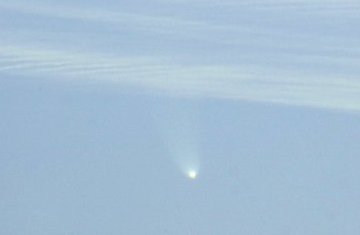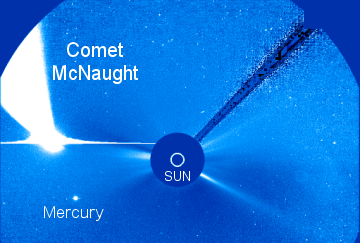 Did you sleep through the auroras of Dec. 14th? Next time get a wake-up call: Spaceweather PHONE.
Did you sleep through the auroras of Dec. 14th? Next time get a wake-up call: Spaceweather PHONE.
DAYTIME COMET: Comet McNaught is now visible in broad daylight. "It's fantastic," reports Wayne Winch of Bishop, California. "I put the sun behind a neighbor's house to block the glare and the comet popped right into view. You can even see the tail."
This trick is best performed around local noon: Go outside and stand in the shadow of a building. Face south. The comet lies 5 degrees to the left of the sun. (Five degrees is the width of your fist held at arm's length.)
 Photo credit: Thorsten Boeckel of Bavaria, Germany
Photo credit: Thorsten Boeckel of Bavaria, Germany
You may not see anything at first, but don't give up. Scan the blue sky until your eyes alight upon the comet. Once seen, you'll wonder how you could've missed it.
This weekend is a special time for Comet McNaught because it is passing close to the sun. Solar heat is causing the comet to vaporize furiously and brighten to daylight visibility. At magnitude -4 to -5, McNaught is the brightest comet since Ikeya-Seki in 1965.
Binoculars dramatically improve the view of the comet, allowing you to see structure within the tail. But please be super-careful not to look at the sun. Direct sunlight through binoculars can cause permanent eye damage.
Comet McNaught Photo Gallery
[finder chart] [ephemeris]
THE VIEW FROM SPACE: Out in space, there are no buildings to block the sun. SOHO uses a coronagraph--a telescope with an opaque disk in the middle. The disk blocks the sun to reveal nearby stars, planets and comets. This is today's view:

Comet McNaught is so bright, it is saturating the spacecraft's digital camera. The horizontal line through the comet's head is a result of saturation, as is the strangely uniform appearace of the comet's tail. Nevertheless, it is a beautiful view. Click here for updates.

